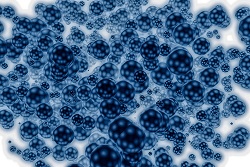Nanoparticle drug delivery to tackle antibiotic resistance
Mycobacterium tuberculosis, the causative agent of tuberculosis, is an intracellular pathogen. When targeting such pathogens, the selected drug must be able to cross the eukaryotic cell membrane to ensure therapeutic success. However, not all antibiotics achieve the therapeutic intracellular concentration, resulting in antibiotic resistance and emphasising the need for improved drug delivery systems capable of penetrating infected cells. Nanocarriers based on biocompatible cyclic oligosaccharides known as cyclodextrins (CDs) are emerging as promising delivery vehicles for antibiotics. They exhibit excellent biocompatibility in humans, low toxicity and absence of immune stimulation even at high dosages. Importantly, they can effectively incorporate a series of active molecules that protect them from degradation, thereby increasing drug bioavailability and decreasing treatment duration. CD nanocarriers are particularly being considered for treating tuberculosis as well as bacteria species most frequently implicated in hospital infections. With a focus on tuberculosis, the EU-funded CYCLON HIT(opens in new window) project aimed to design, characterise and evaluate the efficacy of CD-based nanocarriers. Nanoparticles for treating tuberculosis Tuberculosis constitutes a major health issue with millions of infected individuals worldwide. The misuse of first-line drugs may lead to multidrug-resistant tuberculosis, which is subsequently treated with chemotherapy or second-line drugs such as ethionamide (ETH). However, patients often find it difficult to comply with treatment regimens that require high doses of ETH. Recent studies have discovered that certain ‘booster’ molecules significantly increase ETH efficacy, improving the clinical treatment of drug-resistant tuberculosis. “We wanted to investigate the simultaneous delivery of ETH and booster molecules using CD nanoparticles,″ explains project coordinator Dr Ruxandra Gref. Researchers focused on pulmonary administration of the nanoparticles since lungs are the primary site of Mycobacterium tuberculosis infection. This approach helped achieve higher drug concentrations at the target site and less systemic side effects. Following treatment in an animal model for tuberculosis, researchers observed a significant decrease in lung mycobacterial load. “Considering that the current regimen for tuberculosis consists of a cocktail of drugs, the CYCLON HIT approach could be employed to encapsulate synergic drugs, considerably simplifying the treatment and increasing patient compliance,″ continues Dr Gref. The next era in antibiotic design Drug resistance does not only prevail in healthcare environments due to selection pressure or drug abuse. Resistance is increasing amongst community-acquired pathogens as well due to continuous exposure to low doses of antibiotics contained in foods, for example. Given that bacteria respond to the selective pressure of antibiotics by continuously mutating and acquiring resistance genes, sustained research efforts are needed for to deliver well-documented existing drugs in an optimised fashion. Towards this goal, “The CYCLON HIT project trained the next generation of highly educated researchers to deal with the complex issues related to the increasing antibiotic resistance,″ outlines Dr Gref. Early Stage and Experienced Researchers undertook interdisciplinary training in chemistry, nanotechnology, microbiology and in vivo studies. The consortium also organised three workshops, two summer schools and numerous outreach activities. The teams involved went beyond their initial objectives by organising a congress at the Pasteur Institute in Paris in 2015 and a “brokerage and pitching” event in Orsay in 2018, bringing together several EU projects. Furthermore, Prof. Thorsteinn Loftsson and Dr Gref edited a special issue of a high impact journal(opens in new window) in the field where CYCLON HIT partners made significant contributions concerning the use of CDs to fight serious diseases. Exploiting the most recent advances in the nanomedicine field, CYCLON HIT partners envision alternative therapeutic approaches for other resistant microorganisms besides Mycobacterium tuberculosis. “Intelligent nanoparticles capable of delivering drugs to the site of infection with minimal side effects are certainly the choice of the future,” claims Dr Gref.







